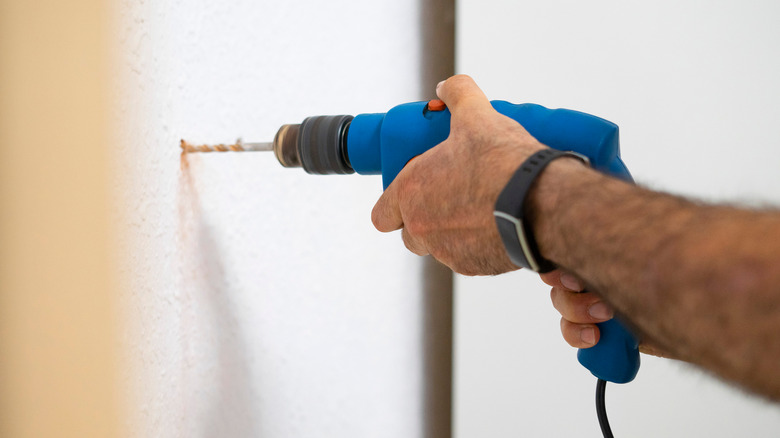What You Need To Know To Wall-Mount A TV
Wall-mounted TVs offer a sleek, modern look to any room and can free up valuable floor space. If you're considering mounting your TV on the wall, there are a few things you need to take into account before getting started. According to Techlicious, there are many benefits to mounting a TV, including reducing glare from lights and windows, improved aesthetics, and saving space. In addition, they also estimate that 120 million households own a TV.
Make Use Of explains that there are a few things to consider before mounting a TV, such as the type of wall, the stud location, and the size of the TV. You'll also want to think about the weight of the TV and the type of mount you'll need. Whether it's your first time mounting a TV, or you're just looking for a refresher course, here's what you need to know to ensure a successful installation.
The right equipment
Before you get started, it is important to make sure you have the proper equipment. According to Make Use Of, before you begin, you will need a stud detector, a power drill, a tape measure, a screwdriver, a suitable wall-mount and fasteners, and a pencil. You may also need a spirit level, depending on the type of mount you're using. If your power drill requires a plugged-in power source, make sure the cord is long enough to reach the outlet.
Pick the correct TV mount
The type of TV mount needed will vary depending on the size and weight of your TV. Home Depot lists several different types of wall mounts, including fixed, swivel, tilting, and full-motion. Fixed TV mounts keep the TV in a single stationary position, while a swivel mount allows the television to pivot from right to left. Tilted wall mounts allow the viewer to angle the TV up or down, while a full-motion mount allows for manual adjustment to almost any angle.
Choose the height and location
Most people already have an idea of where they want their TV, but it's important to consider the location and height. Home Depot recommends choosing an area that has easy access to power outlets and cable input sources. Make sure you select a wall that avoids direct sunlight. You can also install a shelf or place a stand underneath the TV for extra storage. For optimal viewing, make sure the bottom of the display isn't above eye level when sitting and that the top of the display isn't above eye level when standing.
Locate the wall studs
Before securing a mount to a partition wall, it's important to locate the studs. This will ensure that your TV is properly supported and won't fall. According to Home Depot, you'll need an electronic stud finder, which will make the process easier. You can also find studs through other methods such as tapping the wall, using windows and light switches for reference, and even stud finder apps if they are made from metal, notes Good Housekeeping. Once you've found the studs, mark their location with a pencil so you know where to drill.
Attach the mount
Home Depot recommends measuring and positioning the wall mount before attaching it to the wall. This way, you can make sure it's level and in the right spot. It helps to hold the wall mount up against the wall and use a spirit level to make sure it's even. Once you're confident of the position, use a drill to make pilot holes in the wall where you marked the studs. It's also recommended that you have a friend help you, as mounting larger TV can be a two-person job.
Securely mount your TV
Now it's time to actually mount the TV to the wall. Home Depot recommends following your manufacturer's instructions for this part, as each mount is different. Remember that TVs can be heavy, so be careful when attaching it the mount. Alternatively, have a friend help support the TV while you're attaching it to the wall. Once it's secure, don't forget to check your connections and make sure everything is plugged in properly.






